North-Eastern (I-San) Thailand and Laos, 16 Nov - 10 Dec 2015 (25days)

The ruins of Prasat Muang Tam is a rectangular shape 120m by 127meters and is made of laterites, sandstone and bricks. The main entrance faces east.
Day 16 (1.12.2015) Buri Ram - day visit to 3 places (219km)
Buri Ram is known as City of Stone Sanctuaries and volcanic mountains. On day 16 we hired a private car to visit 3 places that are about 70km away from Buri Ram. The 3 places are (1) Prasat Muang Tam and Barai Mueang Tam, (2) Phanom Rung Historical Park and (3) Wat Khao Angkhan. No 2 and 3 are 8km apart and both are dedicated to the Hindu god, Shiva. The architecture is ancient Khmer style and were built and renovated during 10th-11th centuries.
Sleeping at Kaysorn Place, Buri Ram with breakfast.

The ruins of Prasat Muang Tam is a Khmer temple in Prakhon Chai district in Buri Ram Province. It was a Baphuon style which dates its primary phases of construction to the late 10th and early 11th centuries sponsored by King Jayavarman V.

The floor of the archway east of the central building, Prasat Muang Tham, was carved with a 8-petaled lotus flower representing a place of spiritual prayer for those who worship the deity as an auspicious sign .

The ruins of Prasat Muang Tam in Buri Ram Province.

This lintel depicts the Lord Himalayas giving his daughter, Parvati or Uma to the God Shiva in Prasat Muang Tam.

The lintels over the Prasat Muang Tam gate entrance contain 10 centuries old wonderfully carved high relief depictions of Shiva, Uma and other Hindu mythological figures.

Once inside the Prasat Muang Tam temple complex outer wall you will see the inner wall and 4 ponds with 4 steps leading to the bottom of the pond. The ponds are filled with water lilies with large headed Naga snakes placed at the corner of each pond.

Prasat Muang Tam inner wall has quiet setting as the large ponds create a serene and peaceful atmosphere.

One of the 4 lotus L-shaped ponds which follow the shape of the outer wall, representing the oceans, ring the prang and are themselves surrounded by whimsical 5-headed naga in Prasat Muang Tam.

The ponds in Prasat Muang Tam added a lot to its appeal. The edge of each pond has a 5-headed Naga serpent which forms a rail (with its body) around the pond.

Prasat Muang Tam is said to be the female counterpart to the male Prasat Phanom Rung about 8 km away.

The ruins of Prasat Muang Tam in Buri Ram Province.

Prasat Muang Tam temple complex has a rectangular plan and is surrounded by a laterite outer wall. The center of each side of the wall contains a gate, the Eastern one being the main entrance.

At the center of each Prasat Muang Tam gallery wall has an entrance gate or gopura that leads to the inner sanctuary where Hindu ceremonies were held.

The inner sanctuary of Prasat Muang Tam contains 5 towers made from sand stone built on top of a low platform with the central one, which was the tallest has collapsed. It represented Mt Meru, the center of the Universe and it contained a linga representing the strength of Shiva. It is surrounded by 4 smaller towers. The inner sanctuary also contains a library, where the sacred Hindu scriptures were kept.

Prasat Muang Tam complex was built as a shrine to Shiva has the five prang (Khmer-style stupa) are grouped three in front and two in back. The principal prang, likely representing Mt Kailasa, Shiva's home, could not be rebuilt.

A gallery (long narrow corridor) surrounds the main towers and the library. In the middle of each Prasat Muang Tam gallery wall is a door, aligned with the doors of the outer wall.

Looking up inside the Prasat Muang Tam tower.

The ruins of Prasat Muang Tam in Buri Ram Province.

The inner wall surrounding the Prasat Muang Tam temple.

The inner wall surrounding the Prasat Muang Tam temple.

The ruins of Prasat Muang Tam is a Khmer temple in Prakhon Chai district in Buri Ram Province. It was a Baphuon style which dates its primary phases of construction to the late 10th and early 11th centuries sponsored by King Jayavarman V.

The floor of the archway east of the central building, Prasat Muang Tham, was carved with a 8-petaled lotus flower representing a place of spiritual prayer for those who worship the deity as an auspicious sign .

The ruins of Prasat Muang Tam in Buri Ram Province.

This lintel depicts the Lord Himalayas giving his daughter, Parvati or Uma to the God Shiva in Prasat Muang Tam.

The lintels over the Prasat Muang Tam gate entrance contain 10 centuries old wonderfully carved high relief depictions of Shiva, Uma and other Hindu mythological figures.

Once inside the Prasat Muang Tam temple complex outer wall you will see the inner wall and 4 ponds with 4 steps leading to the bottom of the pond. The ponds are filled with water lilies with large headed Naga snakes placed at the corner of each pond.

Prasat Muang Tam inner wall has quiet setting as the large ponds create a serene and peaceful atmosphere.

One of the 4 lotus L-shaped ponds which follow the shape of the outer wall, representing the oceans, ring the prang and are themselves surrounded by whimsical 5-headed naga in Prasat Muang Tam.

The ponds in Prasat Muang Tam added a lot to its appeal. The edge of each pond has a 5-headed Naga serpent which forms a rail (with its body) around the pond.

Prasat Muang Tam is said to be the female counterpart to the male Prasat Phanom Rung about 8 km away.

The ruins of Prasat Muang Tam in Buri Ram Province.

Prasat Muang Tam temple complex has a rectangular plan and is surrounded by a laterite outer wall. The center of each side of the wall contains a gate, the Eastern one being the main entrance.

At the center of each Prasat Muang Tam gallery wall has an entrance gate or gopura that leads to the inner sanctuary where Hindu ceremonies were held.

The inner sanctuary of Prasat Muang Tam contains 5 towers made from sand stone built on top of a low platform with the central one, which was the tallest has collapsed. It represented Mt Meru, the center of the Universe and it contained a linga representing the strength of Shiva. It is surrounded by 4 smaller towers. The inner sanctuary also contains a library, where the sacred Hindu scriptures were kept.

Prasat Muang Tam complex was built as a shrine to Shiva has the five prang (Khmer-style stupa) are grouped three in front and two in back. The principal prang, likely representing Mt Kailasa, Shiva's home, could not be rebuilt.

A gallery (long narrow corridor) surrounds the main towers and the library. In the middle of each Prasat Muang Tam gallery wall is a door, aligned with the doors of the outer wall.

Looking up inside the Prasat Muang Tam tower.

The ruins of Prasat Muang Tam in Buri Ram Province.

The inner wall surrounding the Prasat Muang Tam temple.

The inner wall surrounding the Prasat Muang Tam temple.

Barai Mueang Tam

Just north of Prasat Muang Tam is a lake or barai, which measures 510 by 1090 meters and is 3 meters deep that served as a water reservoir. The lake symbolizes the ocean that surrounds Mount Meru, the center of the universe in Hindu cosmology.

At Phanom Rung Historical Park - The many stores along the walkway up to Phanom Rung.

At Phanom Rung visitor centre along the walkway. This visitor centre beside the entrance displays many artifacts, interactive models, maps and historical information.

At Phanom Rung visitor centre.

A scaled model of Phanom Rung at the visitor centre.
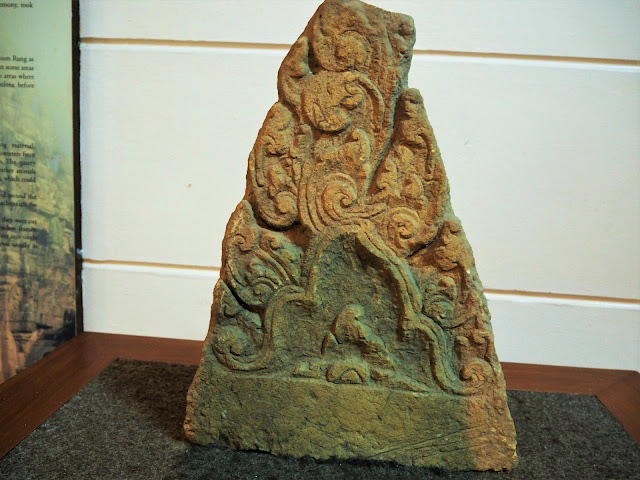
Shiva, Uma and other Hindu mythological reliefs at the Phanom Rung Visitor Center.

Shiva, Uma and other Hindu mythological reliefs at the Phanom Rung Visitor Center.

Shiva, Uma and other Hindu mythological reliefs at the Phanom Rung Visitor Center.

Shiva, Uma and other Hindu mythological reliefs at the Phanom Rung Visitor Center.

Shiva, Uma and other Hindu mythological reliefs at the Phanom Rung Visitor Center.

Shiva, Uma and other Hindu mythological reliefs at the Phanom Rung Visitor Center.

A human skeleton at the Phanom Rung Visitor Center.

The laterite lower staircase is divided into three levels at Phanom Rung Historical Park.

After the 3-leveled Phanom Rung lower stairway is the first platform, giving a first peek at the main temple. The first platform sits atop a ridge and from here the 160-metre long pathway paved in laterite and sandstone, and lined with 70 lotus bud sandstone pillars marks the start of the symbolic journey from earth to Mount Meru, the heavenly abode of the gods.

Chew Leng Soon, Chan Meng Fye, Chia Chai Ling, Ching Neng Bin before the 1st Naga bridge with Phanom Rung in the background.

The Phanom Rung walkway leads to the first of 3 naga bridges. This 1st bridge represents the connection between heaven and earth and leads to the upper 5 stairways with terraces on it.

The Phanom Rung 8 petaled lotus motif in the center of the 1st naga bridge with a view back along the processional walkway.

One of the impressive Phanom Rung naga heads on the 1st bridge. The 5-headed snakes face all 4 directions and are from the 12th century.

Carving of lotus flower with 8 petals on the Phanom Rung terrace.

Ching Neng Bin and Chan Meng Fye on the Phanom Rung terrace.

Another wide Phanom Rung terrace after the 1st naga bridge and before the upper stairway.

The Phanom Rung upper stairway leads to the top. It is divided into 5 sets, each with its own terrace.

At the top of the Phanom Rung stairway there is the last wide terrace area with 4 lotus filled ponds, as well as the outer wall of the temple, which can be accessed via this rather impressive doorway. Through this east door you can see the light of the inner gallery, and in fact, all the way through the main tower and out the other west side of the temple complex.

The Phanom Rung walkway leading to the 2nd naga bridge at the entrance door onto the main tower.

Reached by stone stairway and punctuated by several exquisite lintels, “heavenly” is the right word.

Phanom Rung relief on front pediment of the eastern gate “Yogadakisnamurti” which refers to the story of Shiva was depicted as a Rishi holding a rosary in his right hand, sitting with his right leg extended in a posture known as ‘lalitasana’ surrounded by attendants. He had a power to heal ailment with his magical invocation.

Phanom Rung relief on front pediment of the eastern gate “Yogadakisnamurti”.

The Phanom Rung room roof. After the outer gallery one reaches the inner gallery with long and narrow rooms and served as a wall around the principal tower.

Another Phanom Rung room roof in the last gallery that leads to the 3rd and last naga bridge.

The main Phanom Rung tower is in the center of this ancient shrine & is built from pink sandstone. It is believed to be built by Narendraditya, a descendant of the Mahidharapura dynasty and related to King Suryavarman ll, the creator of Angkor Wat in the 12th century AD.

Phanom Rung pediment was depicted of ‘Shiva Nataraja’ or the dancing Shiva. It was believed that his dancing might be creation as well as destruction at the same time with an appropriate delivery, his dance would bring peace to the earth, but with heated delivery, it could be so disastrous that one was a depiction of his dancing on mount Kailash.

The ten-armed god was dancing on an alter surrounded by a group of deities including Ganesha, Brahma and Vishnu. One of the two women on the right should be the evil incarnation of goddess Uma, the royal consort of Shiva. The other might stand of Karaika Lammaiyar one of Shiva’s royal female disciples.
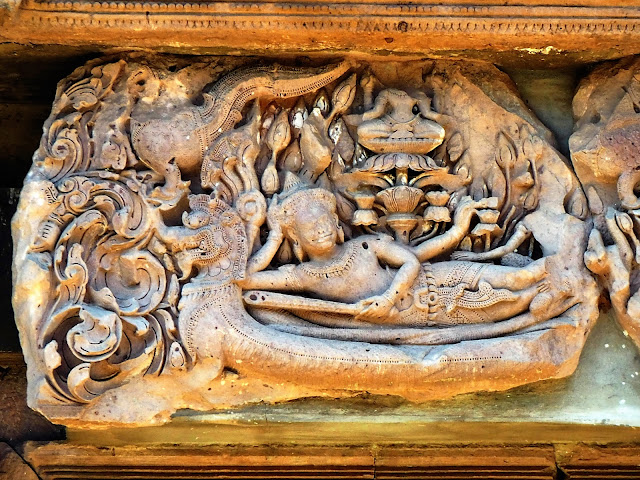
Most of the tower's motifs were carved with stories of Hindu divinities such as dancing Shiva & the recline Vishnu lintel. Others are from the Ramayana.

This pediment was depicted a scene from Ramayana. Rama, Lakshmana and Sita were nearing Panchavati’s place. Ravana having a strong desire for Sita and had Marij disguised himself as a gold deer. Rama and Lakshmana followed the deer into the forest. Ravana then disguised himself as a Rishi abducted her and flew back to Lanka on his horse-drawn carriage. On the way, he was hindered by the bird ‘Jatayu’ who informed Rama of what had really happened and that Jatayu breathed its last.This pediment was depicted a scene from Ramayana. Rama, Lakshmana and Sita were nearing Panchavati’s place. Ravana having a strong desire for Sita and had Marij disguised himself as a gold deer. Rama and Lakshmana followed the deer into the forest. Ravana then disguised himself as a Rishi abducted her and flew back to Lanka on his horse-drawn carriage. On the way, he was hindered by the bird ‘Jatayu’ who informed Rama of what had really happened and that Jatayu breathed its last.

Phanom Rung - In the middle the remains of an eight petaled lotus carving can be seen.

Phanom Rung - In the middle the remains of an eight petaled lotus carving can be seen.

Phanom Rung - In the middle the remains of an eight petaled lotus carving can be seen.

Phanom Rung - In the middle the remains of an eight petaled lotus carving can be seen.

Nandin was the son of Kassayapa and Surabhi. Shiva wanted Surabhi to be his follower but minded her being female. So Kassayapa volunteered to mate the cow who gave birth the full named Nandin, presented to be the Shiva’s guardian, together with Mahakala of the eastern entrance to Shiva’s residence on Kailasa Mountain and turned into a bull and acted as his vehicle when Shiva went out.

Phanom Rung Historical Park.

Phanom Rung Historical Park.
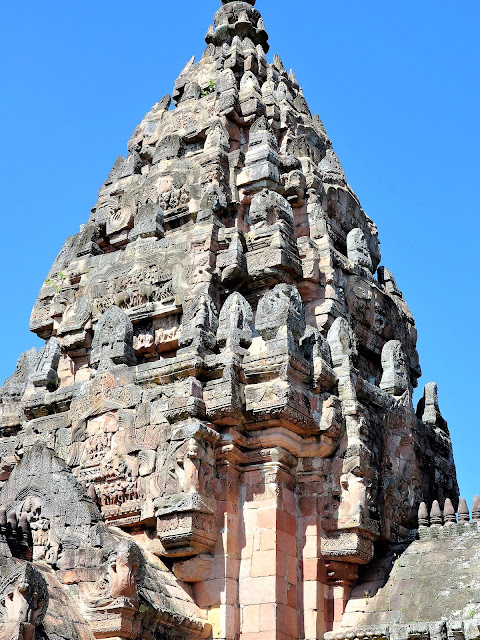
Phanom Rung Historical Park.

Phanom Rung was a religious sanctuary built between the 9th and 12th centuries as part of the larger Angkor Empire.

Phanom Rung Historical Park - This is rectangular room in the Principal Tower. This room assumed to have been used for religious ceremonies for the king. As evident from the discovery of linga or lingam, a symbolic image representing the God Shiva, and within the garbhagriha where statues of revered deities were enshrined. Moreover, at the north floor of this room had carving of ditch for holy water with joint sandstone drain as it passes the courtyard and the north gallery.

Phanom Rung Historical Park.

The roof of the Phanom Rung temple.
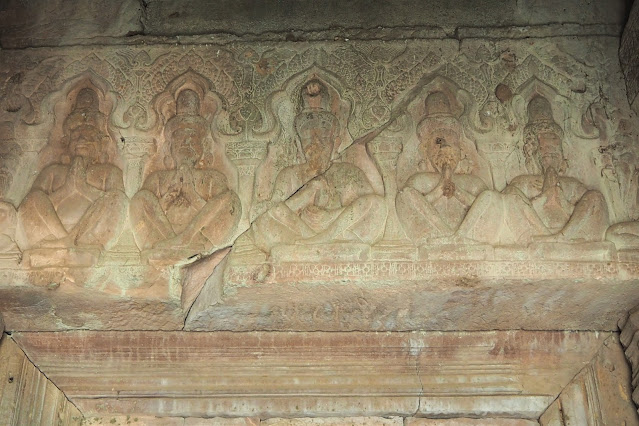
Phanom Rung temple.

Phanom Rung temple was dedicated to the Hindu god, Shiva, with the 200 metre-high volcano subbing for India’s Mount Kailash as the god’s heavenly abode.

The Phanom Rung Historical Park is situated on top of an extinct volcano 200m high. Phanom Rung means "high mountain". Dedicated to Lord Shiva its hill & sanctuary are symbols of mountain Kailasa with Shiva's patheon, & symbolizes the centre of the universe.

The Phanom Rung inner gallery is a large space dominated by the main temple where the main rites would have taken place, and was also home to the linga – the symbol of Shiva.

The layout of the Phanom Rung temple is such that on certain days during the year, one can stand at the westernmost entrance and see the rising sun through all 15 doors.

Noticed the Khmer-temple guard on the south side at Phanom Rung Temple.

Prang Noi or minor sanctuary is in the south west of the main tower. In it there is a sandstone altar for holding sacred image. Its pediment in the east depicts Krishna lifting a mountain among floral motifs.

Phanom Rung southeast are 2 libraries among the last structures built within the temple in the 13th century.

There are additional gates at each of the other three sides of the Phanom Rung gallery. The north and south gates don't lead anywhere, but the west gate leads down to a rest area where there is a good view of the countryside.

Finally, a shot from the west side of Phanom Rung, having emerged through the outer wall, there are lovely views of the surrounding area which will impress you which make all the stairs climbed to this point seem worthwhile!

Noticed the false windows on my right and left side of the outer sanctuary west wall, at the Phanom Rung Temple.

Phanom Rung Temple.

Phanom Rung Temple.

Phanom Rung Temple.

Khao Phra Angkhan

Wat Khao Angkhan is located on an extinct volcano and is 20km from Prasat Phanom Rung. Sandstone boundary markers found here are proof of a past dating back to 8th and 9th century.

A Chinese-style pagoda and a huge golden 29m reclining Buddha next to the Wat Khao Angkhan car park.

We did take some effort to get to Wat Khao Angkhan, but worth after hitting Phanom Rung and Muang Tam.

The Wat Khao Angkhan entire complex is surrounded by rows of large seated Buddha images.

The Wat Khao Angkhan entire complex is surrounded by rows of large seated Buddha images.

Wat Khao Angkhan is thought to have served as a religious sanctuary during the Dvaravati period in the 8th and 9th centuries, evidenced by sandstone markers inscribed with images of people, lotuses and Dharma wheels.
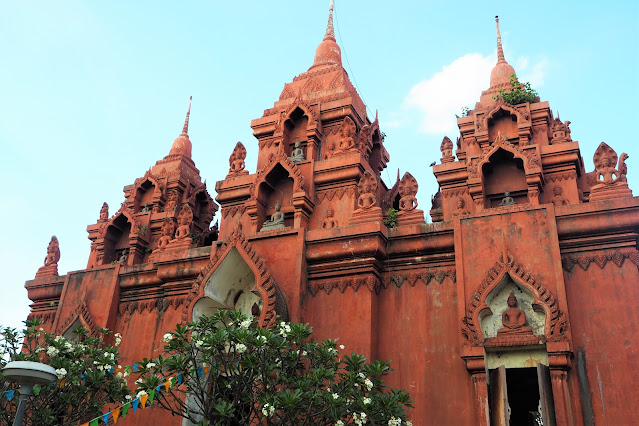
The Wat Khao Angkhan eye-catching structure is the clay-red ordination hall topped by depictions of Khmer-style gateways leading up to Sri Lankan style bell-shaped chedis.

The two main buildings at Wat Khao Angkhan.

Wat Khao Angkhan

The murals on the Wat Khao Angkhan wall are drawn by Burmese artists with Buddhist legends in English.

Wat Khao Angkhan

Wat Khao Angkhan
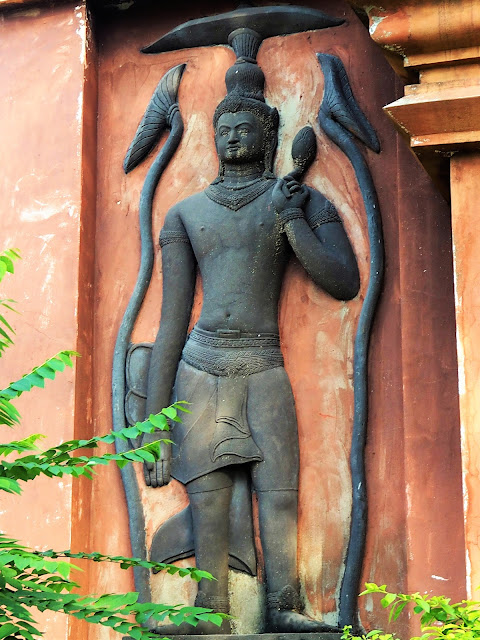
Wat Khao Angkhan

Wat Khao Angkhan

Wat Khao Angkhan

Wat Khao Angkhan

Wat Khao Angkhan

Wat Khao Angkhan

Wat Khao Angkhan

The shrine at Wat Khao Angkhan.

The shrine at Wat Khao Angkhan.

The shrine at Wat Khao Angkhan.

Our dinner at Tee Pak 2 restaurant located opposite Thanachart Bank in Buri Ram (literally means "pleasant city"). "Sai mu thot" a deep-fried pork intestines, minced pork, herbs and curry paste.

This dish is the deep-fried 'pla krai' or clown knife-fish. It is served with a spicy dipping sauce on the side made from coriander root, lime juice, chilies, garlic, sugar and fish sauce.

Tom Yam soup. A hot and sour broth made from lemon grass, galangal, kaffir lime leaves, dried chillies and lime juice, usually with prawns (Tom yam kung) or chicken (Tom yam kai).

"Phak bung fai daeng" a morning-glory (a.k.a. water spinach) stir fried with yellow bean sauce, garlic and chillies. It is a very popular vegetable dish in Thailand.

Green beans fried with pork.
| Day 16 | Cost Item in Thai Baht | Bus/car | Food | Hotel | Fee | Total | per pax |
| 01.12.2015 | Kasoin Hotel with breakfast | 1,160 | 1,160 | 290 | |||
| Buri Ram | Taxi | 2,000 | 2,000 | 500 | |||
| Kasoin Place | Entrance | 600 | 600 | 150 | |||
| Water | 30 | 30 | 8 | ||||
| Lunch | 330 | 330 | 83 | ||||
| Dinner | 435 | 435 | 109 |
Click below to view:
North-Eastern Thailand and Laos - Introduction
Day 01 (16.11.15) AirAsia AK 856 KUL. 12.45pm to Chiang Mai, (1738km)
Day 02 (17 Nov) Chiang Mai to Loei to Phu Kradueng to Khon Kaen (691km)
Day 03 (18 Nov) Khon Kaen City walk around
Day 04 (19 Nov) Khon Kaen City to Kalasin (80km)
Day 05 (20 Nov) Kalasin to Sakon Nakhon (129km)
Day 06 (21 Nov) Sakon Nakhon to Nakhon Phanom (92km)
Day 07 (22 Nov) Nakhon Phanom - day trip to Thakhek, Laos (62km)
Day 08 (23 Nov) Nakhon Phanom to Mukdahan (125km)
Day 09 (24 Nov) Mukdahan - trip to Phu Pha Thoet National Park (108km)
Day 10 (25 Nov) Mukdahan to Ubon Ratchathani by bus (194km)
Day 11 (26 Nov) Ubon Ratchathani to Pakse to Si Phan Don, Laos (291km)
Day 12 (27 Nov) Si Phan Don - a long walk to Somphamit Waterfall
Day 13 (28 Nov) Si Phan Don to Ubon Ratchathani by bus (291km)
Day 14 (29 Nov) Ubon Ratchathani to Si Sa Ket by van (67km)
Day 15 (30 Nov) Si Sa Ket to Buri Ram by train (148km)
Day 16 (01 Dec) Buri Ram - day visit to 3 places (219km)
Day 17 (02 Dec) Buri Ram to Nakhon Ratchasima by train (129km)
Day 18 (03 Dec) Nakhon Ratchasima - day trip to Phimai (120km)
Day 19 (04 Dec) Nakhon Ratchasima to Bangkok by train (264km)
Day 20 (05 Dec) Bangkok - Chao Phraya River boat ride to Khaosan Road
Day 21 (06 Dec) Bangkok - rest day and dinner at Royal Bangkok Sports Club
Day 22 (07 Dec) Bangkok to Prachuap Khiri Khan by train (320km)
Day 23 (08 Dec) Prachuap Khiri Khan
Day 24 (09 Dec) Prachuap Khiri Khan to Hatyai by night train (660km)
Day 25 (10 Dec) Hatyai to Butterworth by train and to KL by bus (555km)
L-R: Chan Meng Fye, Chew Leng Soon and Ching Neng Bin on the road in Thailand.
///